 |
Wildlife Bridges
| RSPB Spotlight on Badgers book |
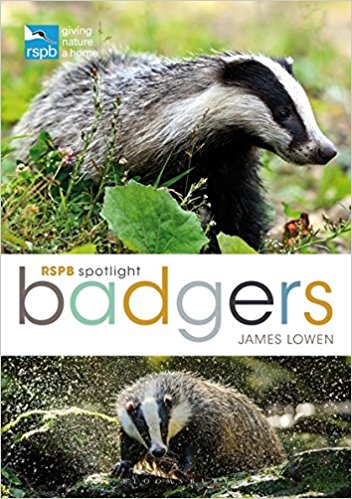 |
James
Lowen explores the lives of badgers and their communal
living, feeding habits and threats to their conservation. Click
here to buy:
Paperback edition
Kindle edition
|
|
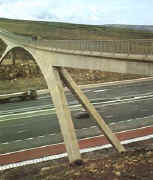 Most people will be familiar with the narrow concrete
footbridges and the concrete cattle bridges
which cross some of our rural motorways. Most people will be familiar with the narrow concrete
footbridges and the concrete cattle bridges
which cross some of our rural motorways.
Sometimes these allow a farmer to
move cattle across a motorway, without the need for the use of
trucks and trailers. Cattle bridges can be fairly narrow, concrete
affairs; as the cattle are herded by the farmer, and forced across
together; and are more than happy to walk along in a tight group.
At other times they are used as narrow concrete footpaths and
horse-riding trails.
|
|
A more recent concept is to build so-called wildlife bridges to
act as a cross-over point for the motorway or a railway line.
Whilst a traditional cattle bridge might only be 2 or 3 metres
wide, a wildlife bridge might be as wide as 20 or 30 or 40 metres or
even wider. The top of
the bridge will be a truly green space, complete with grass and
meadows and shrubs and perhaps even a few small trees. So far as
the car or train driver is concerned, he or she is passing through
a short tunnel. So far as the wildlife is concerned, they appear to be
walking or running across a solid area of safe ground. They are
less spooked by traffic noise from below; and, perhaps just as importantly, less
pressured by other animals or prey species as they can maintain a larger separation
distance between themselves.
|
|
One example of why this is important is that hedgehogs may be in
fear of their lives from badgers; and will avoid badgers as much
as they can. If a badger has marked its territory within the past
3 hours or so, the hedgehog will tend to avoid the area. If a
wildlife bridge was very narrow, this may well mean that the
hedgehogs were always too frightened to cross the bridge; which
might well have a seriously adverse effect on territorial
boundaries and wildlife survival rates - especially where cubs and
prey species are
involved.
|
|
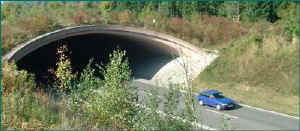 If the wildlife bridge is very wide, a frightened hedgehog may
well be able to cross the bridge on one side, and a scary badger
on the other side; and each species live in comfortable harmony with one
another. If the wildlife bridge is very wide, a frightened hedgehog may
well be able to cross the bridge on one side, and a scary badger
on the other side; and each species live in comfortable harmony with one
another.
|
|
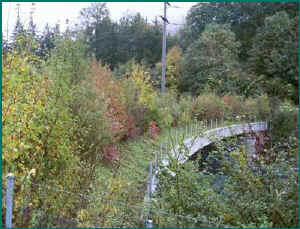 A wide wildlife bridge is also much safer in terms of accident
reduction, as you can be fairly certain that wildlife will not be
on the carriageway; as you can fence them out; and they have a
safe easy route to use instead which looks just like any other bit
of countryside to them. Because the wildlife bridge goes over a motorway or a railway
line, it is obviously much higher up, meaning that there is very
little chance of flooding; and the possibility of catastrophic
pollution damage (such as salt-water run-off or oil-spills) is much reduced. A wide wildlife bridge is also much safer in terms of accident
reduction, as you can be fairly certain that wildlife will not be
on the carriageway; as you can fence them out; and they have a
safe easy route to use instead which looks just like any other bit
of countryside to them. Because the wildlife bridge goes over a motorway or a railway
line, it is obviously much higher up, meaning that there is very
little chance of flooding; and the possibility of catastrophic
pollution damage (such as salt-water run-off or oil-spills) is much reduced.
|
|
It is not beyond the bounds of
possibility that wildlife tunnels might become polluted with oil
or chemicals spills; or with the unpleasant "run-off"
water that washes off major roads. Such run-off water often has damaging levels of
oil and petro-chemicals; and, in winter, may have very
high concentrations of road-salt and grit. Whilst water run-off
may be dealt with by drainage or the double-ditching technique;
this is not always good enough in flood-prone areas and tunnels
may be at risk of flooding or pollution.
|
|
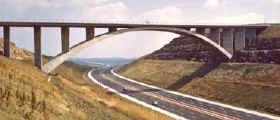 In many circumstances the additional effort required to make a
wildlife bridge (rather than an enormous cutting may not be hugely
significant in terms of the overall cost of the project.
Traditionally the materials dug out of the ground to form the deep
cutting may have been trucked away. With the wildlife bridge, they
can simply be reinstated once the tunnel roofing system has been
put in place. This technique, known as back-filling, was used when
the canals were first being constructed; and has since been used
for railway construction too. In many circumstances the additional effort required to make a
wildlife bridge (rather than an enormous cutting may not be hugely
significant in terms of the overall cost of the project.
Traditionally the materials dug out of the ground to form the deep
cutting may have been trucked away. With the wildlife bridge, they
can simply be reinstated once the tunnel roofing system has been
put in place. This technique, known as back-filling, was used when
the canals were first being constructed; and has since been used
for railway construction too.
|
|
As well as these wide wildlife
bridges allowing animal territories to be maintained, rather than
being divided into smaller, less viable islands; they also have
ancillary effects for the wider countryside. They do provide a
small amount of recompense for the monstrous damage done by laying all that
concrete and tarmac; and they may well be less intrusive in terms
of traffic noise, visual amenity than an enormous great steep-side
cutting. After all, a cutting will always look like an ugly
cutting with a strip of concrete in the bottom. At least a
wildlife bridge will look like a bit of green countryside with a
tunnel underneath!

|
|
|
